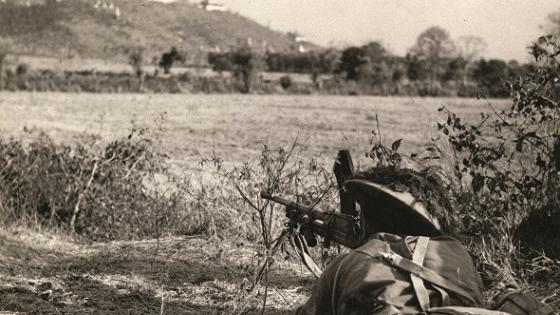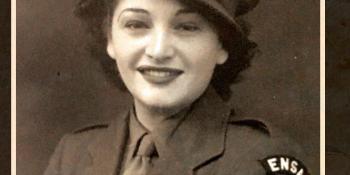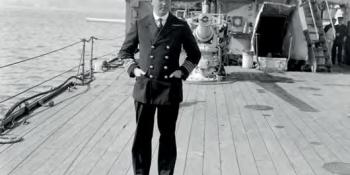
PHOTO: A Bren Gunner firing on enemy positions on Mandalay Hill, March 1945.
The Battle of Mandalay in March 1945 was the final large-scale engagement in Burma. The commander of the 98th Brigade, which captured Mandalay, later presented a lecture on this ‘unique’ battle. His original notes have been rediscovered by Fourteenth Army specialist James Luto, which include first-hand accounts of the fighting. In the second of this two-part series of articles on the race to Rangoon, John Grehan tells the story.

PHOTO: British troops at Meiktila, cutting communications between Mandalay and Rangoon, 13 March 1945.
‘The crisis of the great battle was at hand,’ wrote Lieutenant General William Slim. ‘Kimura’s gaze was fixed on Mandalay and its neighbourhood, his troops faced north and were marching hard to meet us there.’ Kimura was the Japanese general recently placed in charge of the forces in Burma. He was rushing his troops to Mandalay because Slim’s Fourteenth Army had forced its way across the River Irrawaddy and was bearing down on the key northern city of central Burma — but his troops were rushing into a trap.
While the Japanese directed their efforts on Mandalay, British and Indian divisions, which had already crossed the Irrawaddy further downstream, were shortly to capture the road and rail hub of Meiktila and cut Kimura’s communications with Rangoon, the Burmese capital.
Attack and Defence
The 19th Division was to make a rapid thrust down the mud flats of the Irrawaddy to seize Mandalay Hill, the key to the city’s defences. The advance to the city was to be led by a small mobile battle group called ‘Stiletto Force’ drawn from 98th Brigade. This force was to move down the main road to Mandalay supported by the rest of the brigade. The division’s two other brigades were to approach Mandalay from the northeast and the west. This, according to Brigadier Charles Ian Jerrard in his introduction to the battle, was based on the following principles:
– The advance on a broad front
– The early seizure of the tactical advantage
– The need for avoiding the direct attack and use of encirclement
– Non-interference by a higher command until he intends to assume control of the battle himself.
The Japanese plan of defence was spelt out by Jerrard as follows: ‘The enemy intended to hold the city with 15th Division. The main defence line was the double canal line north of Mandalay Hill stretching from the river on the west to the Mandalay Canal in the east, Fields north of the canal were flooded to form a tank obstacle. Defence in depth was provided by Mandalay Hill, the Pagoda fields and Fort Dufferin, all of which were tank proof. Strong defended areas in buildings were formed to cover the east and west gates of the fort.’

PHOTO: Troops of the Indian 19th Division in action against Japanese positions on Mandalay Hill, March 1945.
That at least was the plan but because of the rapid advance by Stiletto Force only a proportion of the Japanese 15th Division had arrived in Mandalay by the time this advance group reached the city. The troops forming the garrison had, however, occupied all the defences except the canal line east and west of Mandalay Hill.
The hill stands 934 feet high and is studded with monasteries and pagodas. The entire hill was regarded as a shrine and, according to Jerrard, instructions were given not to use artillery unless absolutely necessary. ‘On the morning of 8 March the leading units of Stiletto Force, moving down the banks of the Irrawaddy appeared before Mandalay to the complete surprise of the defenders. Large numbers of Japanese were found in the canal area to the northeast of Mandalay Hill. Efforts to dislodge the enemy from this position failed and two tanks were knocked out and “brewed up”.
‘The rest of 98th Brigade arrived in the afternoon and assumed control of the situation. The unit selected to storm Mandalay Hill was 4/4 Gurkha Rifles, the entire battalion having been transported by lorry to keep the men as fresh as possible for the assault.

PHOTO: Men of the Gurkha Rifles clearing out Japanese from their holes in the ground.
‘The Gurkhas were driven one-and-a-half miles north of the railway station and ordered to seize the hill in a silent attack that night. The 8th Battalion 12th Frontier Force Regiment [FFR] moved south overcoming opposition in the Racecourse area during which another tank was lost in action with the enemy along the north moat of Fort Dufferin.’
The 2nd Battalion Royal Berkshire Regiment also made contact with the Japanese in the moat area. The 98th Brigade was now firmly established on the edge of Mandalay. The next move was to take the dominating Mandalay Hill. Brigadier Jerrard then quoted from the Officer Commanding 4/4 Gurkha Rifles:
‘At 17.00 hours 4/4 G.R. moved across country to the Dinga Chaung road. The country was very open and the battalion adopted extended artillery formation. In spite of medium machine-gun fire and anti-tank gun fire there were no casualties.
‘At 17.45 hrs OC 4/4 G.R. met OC 5 Baluch who advised against a frontal attack. OC 4/4 G.R. decided to attack from the northeast.’
The Gurkhas moved round to the northeast and established a firm base at the rifle butts which was to act as a launching pad for the assault on the summit. This was accomplished by 23.30 hours. As the steep and tangled terrain proved impassable for mules, only three companies reached the rifle butts along with HQ Company. The rest of the battalion returned to the main road.
Summit Assault
At 01.00 hours the attack went in. One company, with a section of 3in mortars was to deliver the attack with another in support. HQ and the third company were to remain at the base by the rifle butts.

PHOTO: As the Battle for Mandalay narrows to the one strongly held Japanese fortress (Fort Dufferin), the civic and governmental centre of the city, troops pour into the suburbs and to the town itself, and final mopping up operations go on through the ruins. Here, Lee tanks and infantry of 19th Division can be seen moving into Mandalay, 10 March 1945.
‘The attacking company moved off almost at once,’ continued the lecture, ‘but the company was unable to reach the lower slopes. The leading platoon then, in spite of heavy light-machine-gun fire, secured a footing on the slopes and the rest of the company followed the same route. The company commander then ordered the leading platoon to secure the little Pagoda as a first bound, the other platoons to guard the flanks. This was successfully carried out but when the platoon halted it came under heavy medium-machine-gun fire from the top of the hill.
‘The enemy machine-gun post was knocked out with two Brens. The platoon next assaulted the staircase, about 100 yards away. After a great deal of close fighting the top of the hill was reached about first light. Meanwhile the company commander had put artillery fire onto the Jap position, and later he ordered a second platoon to secure the area from which the leading platoon had assaulted the staircase. At first light the whole company joined up at the top of the hill. An enemy counter attack from the southern slopes was easily repulsed by heavy infantry and artillery fire.
‘At 05.00 hours a fierce counter attack was launched against the firm base from the direction of the Thousand Pagodas. This was also repulsed.’
In typical fashion the Japanese refused to give in even though the summit and the western slopes had been secured. They had embedded themselves behind rocks, within caves and buildings around the upper slopes. The job of clearing them out was handed to the 2nd Royal Berks.
‘The clearance of the hill was an epic,’ Major D.P.R. Sterling contributed to the lecture. ‘Fighting had to be confined to the razor backed top of the hill where the Japanese were under cover on the concrete pagodas protected by iron bars. They had to be burned out with petrol and Bee Hive charges.’ These were used to blow holes through walls of houses, being particularly effective in urban warfare.

PHOTO: Taken during the fighting in the streets of the city, this photograph shows a pagoda, which had been turned into a Japanese stronghold, burning from fierce Allied artillery fire.
Note the racecourse on the right, March 1945.
It was at 08.30 hours on 9 March that one company of the Royal Berks, plus a troop of Lee tanks of the 150th Regiment Royal Armoured Corps was ordered to clear the area up to Shwegyin, at the southwest foot of the hill. It took until 14.00 hours to drive back the Japanese. With the foot of the hill cleared the Royal Berks were ordered to relieve 4/4 Gurkha on the summit.
During the course of 9 March the Gurkhas killed 83 Japanese and the Royal Berks 73, with comparatively little cost to themselves. One man described fighting the Japanese: ‘The Jap was a brave man. We only ever took one prisoner. He didn’t know what day it was, he was wandering round in a coma … Another we went to pick up, when he saw us coming, he took the pin out of his grenade and blew himself up.’
There were still numbers of the enemy holding out on the hill, as Brigadier Jerrard continued to describe: ‘At 07.00 hours on 10 March one company of 4/4 G.R. moved round by the west of the hill but was held up in the racecourse area by heavy and accurate fire from the walls of Fort Dufferin and the cemetery. The company formed a perimeter near the pagoda.
‘2 Royal Berks less two companies were ordered to take Mandalay City west of the Fort as far as the road running east-west. The other two companies with 3-inch mortars and Divisional artillery at call and under command of 2 i/c were to finally clear Mandalay Hill. At least two 75mm and a 70mm were then shelling the corps from the Fort and the Thousand Pagodas area.
‘Casualties were suffered as it was not possible to dig in. One troop of ‘A’ Tank Squadron, one platoon [of the Royal Berks] and one battery of medium artillery were placed under 2 i/c Royal Berks. He planned a frontal attack at 12.30 hours on the second pagoda, there being no room for manoeuvre.’
In typical fashion the Japanese refused to give in even though the summit and the western slopes had been secured. They had embedded themselves behind rocks, within caves and buildings around the upper slopes.
A driver of one of the tanks was Corporal Arthur Frere of ‘B’ Squadron, 3rd Carabiniers: ‘B Squadron commander was told that his squadron was not required for the attack on Mandalay, it would be A Squadron. He lost his temper and said it was only right for B Squadron to go to Mandalay. The Brigadier told him to calm down. We couldn’t care less. We wanted to get home. However, he was told that one tank of B Squadron could enter Mandalay.’
The attack was delayed an hour to allow the artillery to register on the target then 2 Royal Berks rushed forwards, recorded ….: ‘It got to within forty yards of its objective before being halted by stiff enemy resistance. The approach was only wide enough for a one platoon frontage. A second platoon was in reserve, and the third giving covering fire. Eventually a platoon of the second company was put under command of the leading company; this platoon succeeded in making some progress along the left of the eastern slopes. Exploitation to the pavilion discovered a tunnel held by an enemy party that was unable to get out as all the exits were covered. Attempts to reach the tunnel were stopped by heavy rifle and light-machine-gun fire. In spite of grenades being showered into the tunnel no progress was made. Petrol drums were then thrown in and ignited by 77 grenades.

PHOTO: The 19th Indian ‘Dagger’ Division’s indomitable leader, General Rees (bottom of the Jeep’s aerial mast) watches tank fire on an enemy anti-tank gun position at the base of Mandalay Hill, March 1945.
‘The enemy opened up a very heavy rate of fire and some attempting to escape were killed … By dark the second pagoda position was consolidated.’
The method of flushing out the Japanese from caves and the tunnel adopted by the Royal Berks was described by Gunner James Baker, of 134 Medium Regiment, Royal Artillery: ‘The infantry could not get the Japs out of the caves, so they drilled holes and poured in oil and set fire to it. Most Japs stayed in the caves; others, in full view of us, jumped from the caves all alight. I saw about eight or nine. We had captured the hill but the Japs were still inside.’
By dark the second pagoda position was consolidated. The remainder of 2 Royal Berks, which with one troop of Stuart tanks had been ordered to the west of the city, had come under fire from the woods on their right flank and from the fort. Eventually, after losing one tank, the battalion dug in for the night two blocks to the west of the moat.
That same day, 10 March, also saw 8 FFR launch a daring attack on the North Gate of Fort Dufferin but it was repulsed with some casualties.
The enemy opened up a very heavy rate of fire and some attempting to escape were killed … By dark the second pagoda position was consolidated.
The grandstand was still in enemy hands and on the following day further efforts were made to capture this feature. By this time, however, Brigadier Jerrard had reached Mandalay and, following his stated principles, he took charge of the battle. He decided to make use of the superiority Allied aircraft possessed and he called for an air strike.
Keeping Up Morale
Meanwhile more ‘Bee Hive’ charges arrived. These were exploded on the roof of the grandstand in several places and grenades thrown through the holes. The 1st Battalion 15th Punjab Regiment had also arrived and passed through the Royal Berks in the city west of the fort. As it happened a Japanese man loading a lorry with ammunition was surprised at this time by the Royal Berks. The ammunition went up and there were explosions for one-and-a-half-hours. The Punjabis were extricated from this situation with some difficulty and after suffering casualties.

PHOTO: General Sir Oliver Leese, Commander-in-Chief Allied Land Forces South East Asia (ALFSEA), watches the attack on Fort Dufferin from Mandalay Hill.
Jerrard saw that resistance in the city streets to the west of the fort was too solid and he decided to focus the attack upon the right, or East Gate of Fort Dufferin. For the sake of ‘morale’ the position to the west was maintained but only with a defensive stance.
At this point in the lecture the Officer Commanding 2 Royal Berks wanted the listeners to understand the situation his battalion was in: ‘The Battalion had been in continuous action against the enemy for the previous fourteen days. During the previous three days they had been working as two halves. One half had to clear the top of Mandalay Hill and the other to clear that side of the city to the west of the Fort. By now the company strengths were approximately three officers and sixty other ranks. During the next seen days further casualties were gradually to reduce them to companies of forty-five Other Ranks. When companies are reduced to these numbers, the strain on each individual is greatly increased because a man when not actually fighting is either on patrol or sentry or digging in … Our men were therefore getting increasingly tired but morale was high because of course the Jap was obviously on the run and this was Mandalay.’
Jerrard persisted with his attack on the eastern side of the fort. The main feature on this side was the Taiktaw pagoda which was held in considerable strength by the Japanese. This was attacked on 13 March, and was described by the OC of 4/4 Gurkhas for Jerrard’s lecture: ‘After a preliminary mortar and artillery bombardment the attack went in. The central building was destroyed but attempts to break the outer wall with 6Pdrs failed. The attack was soon held up by medium machine-gun and light machine-gun fire from the East Gate of the fort and the attacking company was ordered to dig in. At 17.00 hours one company of 2 Worcesters arrived to relieve 4/4 Gurkhas. This company reported that the enemy were trying to get away.’ It appeared that the Japanese were not necessarily going to fight and die where they stood.

PHOTO: While the battle was in progress an RAF Hurricane carried out a low level recce flight over the city. This picture shows a burning pagoda situated on the moat-side near Fort Dufferin. The walls of the fort can be seen, 21 May 1945.
All efforts now were directed at breaking into Fort Dufferin and eliminating every Japanese soldier they could find. The old walls of the fort, however, proved to be astonishingly resilient, and its moat too wide to cross. Heavy artillery and aerial bombardment had surprisingly little effect. Attempts were even made to ‘skip’ 2,000lb bombs across the moat and into the walls.
Jerrard’s lecture notes continue on 18 March: ‘Unknown to us Commander of 15 Jap Division received orders to cut his way out of Mandalay as his escape routes were being rapidly closed.’ This is because British and Indian divisions had crossed the River Irrawaddy further south and had captured the town of Meiktila, severing communications between Mandalay and Rangoon.
‘During the night 19/20 March the Japs broke out from the Fort almost unscathed,’ continued Jerrard, ‘except for the loss of a lot of transport which was intercepted by 4 Brigade of the British 2nd Division.
‘Two days later, however, the bulk of the garrison was caught and roughly handled … 400 dead 10 guns and over 30 trucks full of stores being picked up on the battlefield.’

PHOTO: A British soldier stands among the ruins of Mandalay, and Fort Dufferin, 7 March 1945.
The following day the abandoned Fort Dufferin was occupied.
‘So ended the Battle pf the Irrawaddy and the capture of Mandalay,’ concluded Jerrard. ‘The [Japanese] 15th Division during this period lost more than 6,000 men and practically all its guns and transport.’
General Slim’s main objective was Rangoon and with the main Japanese forces cleared from the north of the country the Fourteenth Army could move south to the Burmese capital. There could be no more delay in this move, for the monsoon arrives in Burma in mid-May and its effects last until September. Though the British, African and Indian divisions had learnt how to operate in the wet season, movement would still be severely restricted by the swollen rivers and the flooded roads. Malaria flourishes during the monsoon, which particularly affected the British troops. Indeed, the India Army regiments had to shoulder an increasing burden as the British battalions were much reduced in numbers and strength.
Two days later, however, the bulk of the garrison was caught and roughly handled
It was not the way of the Japanese to retreat and this had proven to be both their strength and their weakness. A tactical withdrawal when circumstances necessitated such a course of action was an anathema to them. This had caused them to defend hopeless positions, such as Mandalay Hill, and they had lost heavily as a result. Ironically, it was their stubborn courage that ultimately was their undoing.
Slim, therefore, expected stiff resistance on the way to Rangoon, and at first this was the case. Admiral Lord Louis Mountbatten, Supreme Allied Commander South East Asia decided on (or more accurately reinstated) an amphibious assault directly upon Rangoon. On 1 May, Operation Dracula was launched with an airborne assault to capture the Japanese gun battery at the estuary of the Rangoon river at Elephant Point. The following day the 26th Indian Division conducted its amphibious assault upon Rangoon only to find the Burmese capital had been abandoned by the enemy.
The race to reach Rangoon before the monsoon had been won.

PHOTO: Days of grim fighting for Fort Dufferin, the last Japanese stronghold in Burma, ended with bloodless occupation on 21 March 1945. The enemy had had enough and pulled out under cover of darkness. Here men cheer as the Union Flag flies again over the fort.
We do not know to whom the lecture was delivered or exactly when, though there are indications that it was at some point in 1947. Jerrard’s notes are somewhat jumbled, having lain in a box for almost 70 years. Nevertheless, they probably constitute the first attempt at describing the Battle of Mandalay. The pages are now brown and faded, and only a proportion of them have been used in this article.
But they include one surprising note. During the lecture one man asked, “If I am permitted to speak I have some humble information to give about this battle”. “Who are you?” asked the lecturer. “I am Lieutenant General Tanka Shinichi of the Imperial Japanese Army and Chief of Staff of the Burma Area Army.” Well, well!
This article by John Grehan first appeared inside the April 2015 issue of Britain at War Magazine. This issue also included articles on the clash between HMAS Sydney and the SMS Emden, the valorous acts of a Commando in the last days of the Second World War, and special content on Gallipoli. To purchase your own digital copy of this, and more of our back issues, please visit our page at Pocketmags: https://pocketmags.com/britain-at-war-magazine/issues




